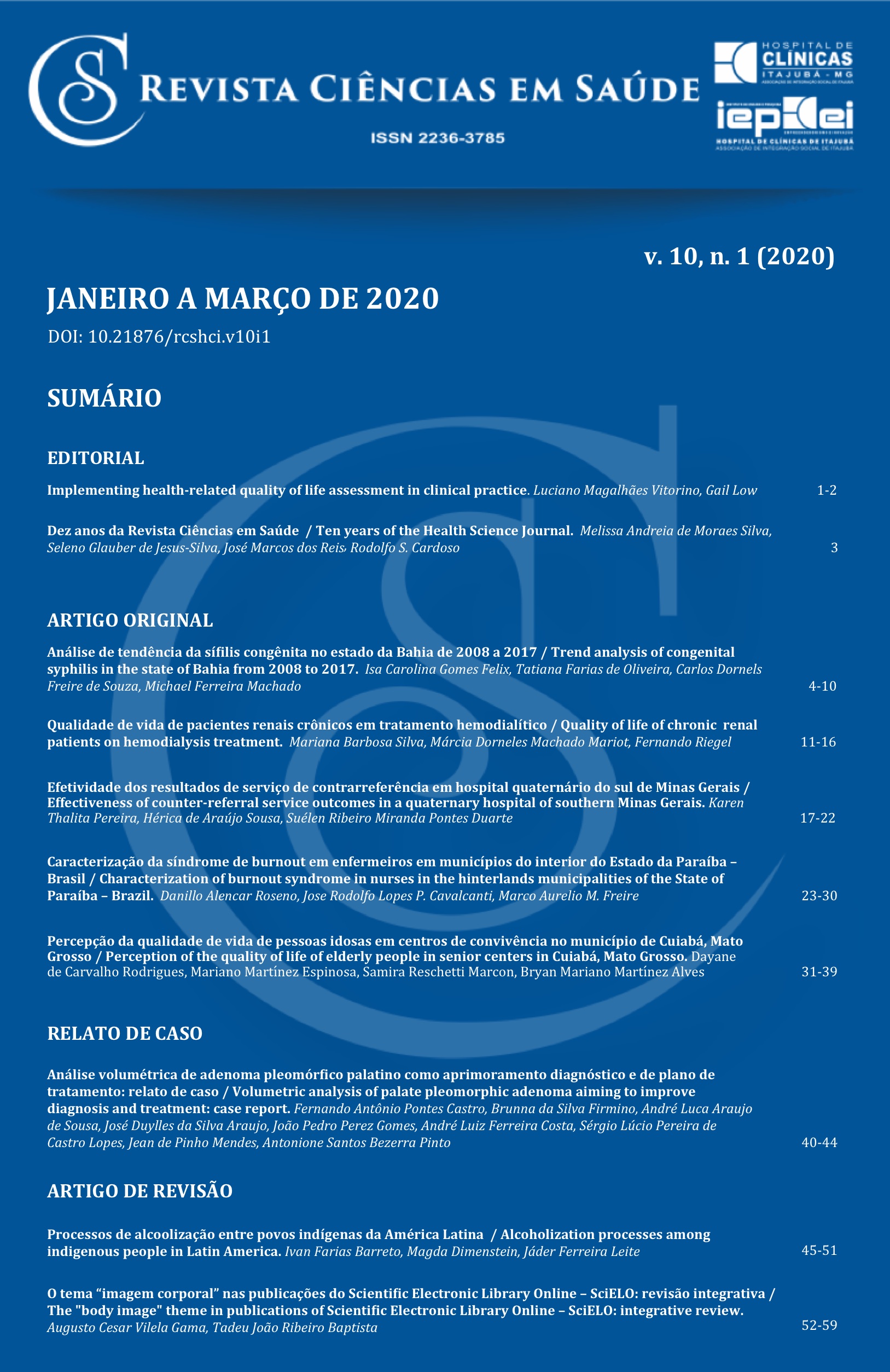Perception of the quality of life of elderly people in senior centers in Cuiabá, Mato Grosso
Main Article Content
Abstract
Introduction: The change in the demographic profile in the world scenario, and the most recent form in Brazil, has among its manifestations, the increase in the number of the elderly population. This increase needs to be accompanied by improved and maintained health and quality of life. Aims: To evaluate the perception of quality of life of elderly people participants of the Social Centers of the city of Cuiabá, Brazil. Methods: Cross-sectional study with 317 elderly participants of the Senior Centers of the city of Cuiabá, conducted from July to December 2012. For data collection used a sociodemographic questionnaire and WHOQOL-BREF and WHOQOL OLD. They used the Mann-Whitney and Kruskal-Wallis tests. Results: The sample was composed mostly of women, aged 60 to 69 years, illiterate, without a partner and with income less than or equal to one minimum wage. The domains with the lowest scores were environment and sensory functioning, while the highest domains were psychological and death and dying. Conclusion: In general, the elderly people had a good quality of life, revealing that the Senior Centers can be a promising alternative for improving the health conditions and quality of life of the elderly.
Article Details
Authors maintain copyright and grant the HSJ the right to first publication. From 2024, the publications wiil be licensed under Attribution 4.0 International 
 , allowing their sharing, recognizing the authorship and initial publication in this journal.
, allowing their sharing, recognizing the authorship and initial publication in this journal.
Authors are authorized to assume additional contracts separately for the non-exclusive distribution of the version of the work published in this journal (e.g., publishing in an institutional repository or as a book chapter), with acknowledgment of authorship and initial publication in this journal.
Authors are encouraged to publish and distribute their work online (e.g., in institutional repositories or on their personal page) at any point after the editorial process.
Also, the AUTHOR is informed and consents that the HSJ can incorporate his article into existing or future scientific databases and indexers, under the conditions defined by the latter at all times, which will involve, at least, the possibility that the holders of these databases can perform the following actions on the article.
References
The WHOQOL Group. The World Health Organization quality of life assessment. (WHOQOL): Position paper from the World Health Organization. Soc Sci Med. 1995;41(10):1403-1409.
Silva PAB, Soares SM, Santos JFG, Silva LB. Cut-off point for WHOQOL-Bref in older adults. Rev Saúde Pública. 2014;48(3):390- 397. doi: 10.1590/S0034-8910.2014048004912
Andradea NB, Canon MBF, Zugman CL, Ayres TG, Ide MG, Novelli MMPC. Centro de convivência de idosos: uma abordagem de estimulação cognitiva e psocossocial. Cad Ter Ocup UFSCar. 2014;22(1):121-8. doi: 10.4322/cto.2014.013
Cruz APM, Muzzi CMC, Santos MD, Mendonça RC. Estudo comparativo da qualidade de vida de mulheres idosas praticantes e não praticantes de atividade física. Geriatr Gerontol Aging [Internet]. 2008 [cited 2020 Mar 19]; 2(4):156-161. Avaiable from: http://ggaging.com/details/323/pt-BR/comparative-study-of-the- quality-of-life-of-elderly-women-practitioners-and-not- practitioners-of-physical-activity
Neves T, Souza MC, Pereira ACD. Qualidade de vida de idosos diabéticos tipo 2 e não diabéticos. R Bras Qual Vida. 2018;10(3):1-15. doi: 10.3895/rbqv.v10n3.8125
Espinosa M M, Oliveira NL, Rodrigues DC, Alves BMM, Marcon SR. Comparação de modelos de regressão entre variáveis quantitativas e categóricas nos estudos de qualidade de vida de idosos. Ci Nat Santa Maria. 2019;41(e26):1-13. doi: 10.5902/2179460X33827 7.
Espinosa MM, Rodrigues DC, Marcon SR. Planejamento amostral probabilístico em estudos comparativos com grupos de idosos. Connection Line [Internet]. 2015 [cited 2020 Mar 19];13:74-84. Avaiable from: http://www.periodicos.univag.com.br/index.php/CONNECTIONLIN E/article/view/247/487
Fleck MPA, Louzada S, Xavier M, Chachamovich E, Vieira G, Santos L, et al. Aplicação da versão em português do instrumento abreviado de avaliação da qualidade de vida “WHOQOL-bref”. Rev Saúde Pública. 2000; 34(2):178-83. doi: 10.1590/S0034-89102000000200012
Fleck MPA, Chachamovich E, Trentini C. Development and validation of the Portuguese version of the WHOQOL-OLD module. Rev Saúde Pública [Internet]. 2006 [cited 2017 Sep 15]; 40(5):785- 791. Avaiable from: http://www.scielo.br/scielo.php?script=sci_arttext&pid=S0034- 89102006000600007&lng=en
Jonckheere AR. A distribution-free k-sample test against ordered alternatives. Biometrika, 1954;41:133-145.
Vitorino LM, Paskulin LMG, Vianna LAC. Quality of life of seniors living in the community and in long term care facilities: a comparative study. Rev Latino-Am Enfermagem. 2013;21(spe):3-11. doi: 10.1590/S0104-11692013000700002
Andrade JMO, Rios LR, Teixeira LS, Vieira FS, Mendes DC, Vieira MA, Silveira MF. Influência de fatores socioeconômicos na qualidade de vida de idosos hipertensos. Ciênc Saúde Coletiva. 2014;19(8):3497-504. doi: 10.1590/1413-81232014198.19952013
Dias DSG, Carvalho CS, Araújo CV. Comparação da percepção subjetiva de qualidade de vida e bem-estar de idosos que vivem sozinhos, com a família e institucionalizados. Rev Bras Geriatr Gerontol. 2013;16(1):127-38. doi: 10.1590/S1809- 98232013000100013
Serbim AK, Figueiredo AEPL. Qualidade de vida de idosos em um grupo de convivência. Scientia Medica. 2011; 21(4):166-72.
Ferreira LK, Meireles JFF, Ferreira MEC. Avaliação do estilo e qualidade de vida em idosos: uma revisão de literatura. Rev Bras Geriatr Gerontol. 2018;21(5):639-51. doi: 10.1590/1981- 22562018021.180028
Sonati JG, Vilarta R, Maciel ES, Modeneze DM, Vilela Júnior GB, Lazari VO, et al. Comparative analysis of quality of life of adult and elderly involved in the practice of regular physical activity. Rev Bras Geriatr Gerontol. 2014;17(4):731-9. doi: 10.1590/1809- 9823.2014.13122
Pagotto V, NakataniAYK, Silveira EA. Fatores associados à autoavaliação de saúde ruim em idosos usuários do Sistema Único de Saúde. Cad Saúde Pública. 2011; 27(8):1593-602. doi: 10.1590/S0102-311X2011000800014
Silva HO, Carvalho MJAD, Lima FEL, Rodrigues LV. Perfil epidemiológico de idosos frequentadores de grupos de convivência no município de Iguatu, Ceará. Rev Bras Geriatr Gerontol. 2011;14(1):123-33. doi: 10.1590/S1809-98232011000100013
Paula GR, Souza BN, Santos LF, Barbosa MA, Brasil VV, Oliveira LMAC. Quality of life assessment for health promotion groups. Rev Bras Enferm. 2016;69(2):242-9. doi: 10.1590/0034- 7167.2016690206i
Tavares DMS, Matias TGC, Ferreira PCS, Pegorari MS, Nascimento JS, Paiva MM. Quality of life and self-esteem among the elderly in the community. Ciênc Saúde Coletiva. 2016;21(11):3557-64. doi: 10.1590/1413-812320152111.03032016
Dawalibi NW, Goulart RMM, Prearo LC. Fatores relacionados à qualidade de vida de idosos em programas para a terceira idade. Ciênc Saúde Coletiva. 2014;19(8):3505-12. doi: 10.1590/1413- 81232014198.21242013
